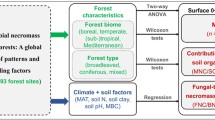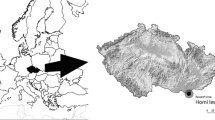Abstract
The pool size of mobile, i.e. non-structural carbohydrates (NSC) in trees reflects the balance between net photosynthetic carbon uptake (source) and irreversible investments in structures or loss of carbon (sink). The seasonal variation of NSC concentration should reflect the sink/source relationship, provided all tissues from root to crown tops are considered. Using the Smithsonian canopy crane in Panama we studied NSC concentrations in a semi-deciduous tropical forest over 22 months. In the 9 most intensively studied species (out of the 17 investigated), we found higher NSC concentrations (starch, glucose, fructose, sucrose) across all species and organs in the dry season than in the wet season (NSC 7.2% vs 5.8% of dry matter in leaves, 8.8/6.0 in branches, 9.7/8.5 in stems, 8.3/6.4 in coarse and 3.9/2.2 in fine roots). Since this increase was due to starch only, we attribute this to drought-constrained growth (photosynthesis less affected by drought than sink activity). Species-specific phenological rhythms (leafing or fruiting) did not overturn these seasonal trends. Most of the stem volume (diameter at breast height around 40 cm) stores NSC. We present the first whole forest estimate of NSC pool size, assuming a 200 t ha−1 forest biomass: 8% of this i.e. ca. 16 t ha−1 is NSC, with ca. 13 t ha−1 in stems and branches, ca. 0.5 and 2.8 t ha−1 in leaves and roots. Starch alone (ca. 10.5 t ha−1) accounts for far more C than would be needed to replace the total leaf canopy without additional photosynthesis. NSC never passed through a period of significant depletion. Leaf flushing did not draw heavily upon NSC pools. Overall, the data imply a high carbon supply status of this forest and that growth during the dry season is not carbon limited. Rather, water shortage seems to limit carbon investment (new tissue formation) directly, leaving little leeway for a direct CO2 fertilization effects.






Similar content being viewed by others
References
Brown S, Lugo AE (1982) The storage and production of organic matter in tropical forests and their role in the global carbon cycle. Biotropica 14:161–187
Bullock SH (1992) Seasonal differences in non-structural carbohydrates in two dioecious monsoon–climate trees. Biotropica 24:140–145
Canadell JG, Pataki D (2002) New advances in carbon cycle research. Trends Ecol Evol 17:156–158
Chapin FS III, Wardlaw IF (1988) Effect of phosphorus deficiency on source–sink interactions between the flag leaf and developing grain in barley. J Exp Bot 39:165–177
Chapin FS, Schulze E-D, Mooney HA (1990) The ecology and economics of storage in plants. Annu Rev Ecol Syst 21:423–447
Clark DA (2002) Are tropical forests an important carbon sink? Reanalysis of the long-term plot data. Ecol Appl 12:3–7
Croat TB (1987) Flora of Barro Colorado Island. Stanford University Press, Stanford
D’Arcy WG (1987) Flora of Panama. Missouri Botanical Garden, St. Louis
Graham EA, Mulkey SS, Kitajima K, Phillips NG, Wright SJ (2003) Cloud cover limits net CO2 uptake and growth of a rainforest tree during tropical rainy seasons. Proc Natl Acad Sci USA 100:572–576
Granados J, Körner C (2002) In deep shade, elevated CO2 increases the vigor of tropical climbing plants. Glob Change Biol 8:1109–1117
Hoch G, Körner Ch (2003) The carbon charging of pines at the climatic treeline: a global comparison. Oecologia 135:10–21
Hoch G, Richter A, Körner Ch (2003) Non-structural carbohydrates in temperate forest trees. Plant Cell Environ 26:1067–1081
Houghton RA, Lawrence KT, Hackler JL, Brown S (2001) The spatial distribution of forest biomass in the Brazilian Amazon: a comparison of estimates. Global Change Biol 7:731–746
Hozumi K, Yoda K, Kokawa S, Kira T (1969) Production ecology of tropical rain forests in southwestern Cambodia. I. Plant biomass. Nat Life Southeast Asia 6:1–56
Hsiao TC, Acevedo E (1974) Plant responses to water deficits, water-use efficiency, and drought resistance. Agric Meteorol 14:59–84
Kitajima K, Mulkey SS, Wright SJ (1997) Seasonal leaf phenotypes in the canopy of a tropical dry forest: Photosynthetic characteristics and associated traits. Oecologia 109:490–498
Körner Ch (1994) Biomass fractionation in plants: a reconsideration of definitions based on plant functions. In: Roy J, Garnier E (eds) A whole plant perspective on carbon-nitrogen interactions. SPB, The Hague, pp 173–185
Körner Ch (2003) Carbon limitation in trees. J Ecol 91:4–17
Körner Ch (2004) Through enhanced tree dynamics carbon dioxide enrichment may cause tropical forests to lose carbon. Phil Trans R Soc London B 359:493–498
Körner Ch, Arnone JA III (1992) Responses to elevated carbon dioxide in artificial tropical ecosystems. Science 257:1672–1675
Körner Ch, Miglietta F (1994) Long term effects of naturally elevated CO2 on Mediterranean grassland and forest trees. Oecologia 99:343–351
Kramer PJ, Koslowski TT (1979) Physiology of woody plants. Academic, New York
Kriedemann PE (1986) Stomatal and photosynthetic limitations to leaf growth. Aust J Plant Physiol 13:15–31
Latt CR, Nair PKR, Kang BT (2001) Reserve carbohydrate levels in the boles and structural roots of five multipurpose tree species in a seasonally dry tropical climate. For Ecol Manage 146:145–158
Lovelock CE, Virgo A, Popp M, Winter K (1999) Effects of elevated CO2 concentrations on photosynthesis, growth and reproduction of branches of the tropical canopy tree species, Luehea seemannii Tr.& Planch. Plant Cell Environ 22:49–59
Magel E, Jay-Allemand C, Ziegler H (1994) Formation of heartwood substances in the stemwood of Robinia pseudoacacia L. II. Distribution of nonstructural carbohydrates and wood extractives across the trunk. Trees 8:165–171
Malhi Y, Grace J (2000) Tropical forests and atmospheric carbon dioxide. Trends Ecol Evol 15:332–337
Marquis RJ, Newell EA, Villegas AC (1997) Non-structural carbohydrate accumulation and use in an understory rain-forest shrub and relevance for the impact of leaf herbivory. Funct Ecol 11:636–643
Mooney HA, Hays RI (1973) Carbohydrate storage cycles in two Californian Mediterranean climate trees. Flora 162:295–304
Mooney HA, Chu C, Bullock SH, Robichaux R (1992) Carbohydrate, water and nitrogen storage in vines of a tropical deciduous Forest. Biotropica 24: 134–139
Neales TF, Incoll LD (1968) The control of leaf photosynthesis rate by the level of assimilate concentration in the leaf: a review of the hypothesis. Bot Rev 34:117–121
Newell EA, Mulkey SS, Wright SJ (2002) Seasonal patterns of carbohydrate storage in four tropical tree species. Oecologia 131:333–342
Phillips OL, Martinez RV, Arroyo L, Baker TR, Killeen T, Lewis SL, Malhi Y, Mendoza AM, Neill D, Vargas PN, Alexiades M, Ceron C, Di Fiore A, Erwin T, Jardim A, Palacios W, Saldias M, Vinceti B (2002) Increasing dominance of large lianas in Amazonian forests. Nature 418: 770-774
Sampson DA, Johnsen KH, Ludovici KH, Albaugh TJ, Maier CA (2001) Stand-scale correspondence in empirical and simulated labile carbohydrates in loblolly pine. For Sci 47:60–68
Schulze ED (1982) Plant life forms and their carbon, water and nutrient relations. Encyc Plant Physiol New Ser 12B:616–676, Springer, Berlin Heidelberg New York
Stitt M, Krapp A (1999) The interaction between elevated carbon dioxide and nitrogen nutrition: the physiological and molecular background. Plant Cell Environ 22:583–621
Taylor J (1993) The mutable carbon sink. Nature 366:515–516
Terry N, Waldron LJ, Taylor SE (1981) Environmental influences on leaf expansion. In: Dale JE, Milthorpe FL (eds) The growth and functioning of leaves. In: Proc Symp Sydney 1981. Cambridge University Press, Cambridge pp 179–205
Tissue DT, Wright SJ (1995) Effect of seasonal water availability on phenology and the annual shoot carbohydrate cycle of tropical forest shrubs. Funct Ecol 9:518–527
Wardlaw IF (1990) Tansley Review No. 27. The control of carbon partitioning in plants. New Phytol 116:341–381
Winter K, Garcia M, Lovelock CE, Gottsberger R, Popp M (2000) Responses of model communities of two tropical tree species to elevated atmospheric CO2: growth on unfertilized soil. Flora 195:289–302
Wong SC (1980) Elevated atmospheric partial pressure of CO2 and plant growth. I. Interactions of nitrogen nutrition and photosynthetic capacity in C3 and C4 plants. Oecologia 44:68–74
Wong SC (1990) Elevated atmospherical partial pressure of CO2 and plant growth. II. Non-structural carbohydrate content in cotton plants and its effect on growth parameters. Photosynth Res 23:171–180
Wright SJ (1996) Phenological responses to seasonality in tropical forest plants. In: Mulkey SS, Chazdon RL, Smith AP (eds) Tropical forest plant ecophysiology. Chapman and Hall, New York, pp 440–460
Wright SJ, Van Schaik CP (1994) Light and phenology of tropical trees. Am Nat 143:192–199
Wright, SJ, Calderón O, Hernandéz A, Paton S (2004) Are lianas increasing in importance in tropical forests? A 17-year record from Panamá. Ecology 85:484–489
Würth MKR, Winter K, Körner Ch (1998a) Leaf carbohydrate responses to CO2 enrichment at the top of a tropical forest. Oecologia 116:18–25
Würth MKR, Winter K, Körner Ch (1998b) In situ responses to elevated CO2 in tropical forest understory plants. Funct Ecol 12:886–895
Zotz G, Winter K (1996) Diel patterns of CO2 exchange in rainforest canopy plants. In: Mulkey SS, Chazdon RL, Smith AP (eds) Tropical forest plant ecophysiology. Chapman and Hall, New York, pp 89–113
Acknowledgements
This research was facilitated by the A.W. Mellon Foundation research grant to C. K. in cooperation with K. Winter, through the Smithsonian Tropical Research Institute, Panama City and Washington D.C. and by Freie Akademische Gesellschaft, Basel. We are grateful to the Smithsonian Tropical Resarch Institute for the use of the canopy crane and for logistic support. We would also like to thank Monica Mejía, Milton García and Pilar Angúlo for field assistance, and Paul Jordan for statistical consultations.
Author information
Authors and Affiliations
Corresponding author
Rights and permissions
About this article
Cite this article
Würth, M.K.R., Peláez-Riedl, S., Wright, S.J. et al. Non-structural carbohydrate pools in a tropical forest. Oecologia 143, 11–24 (2005). https://doi.org/10.1007/s00442-004-1773-2
Received:
Accepted:
Published:
Issue Date:
DOI: https://doi.org/10.1007/s00442-004-1773-2




